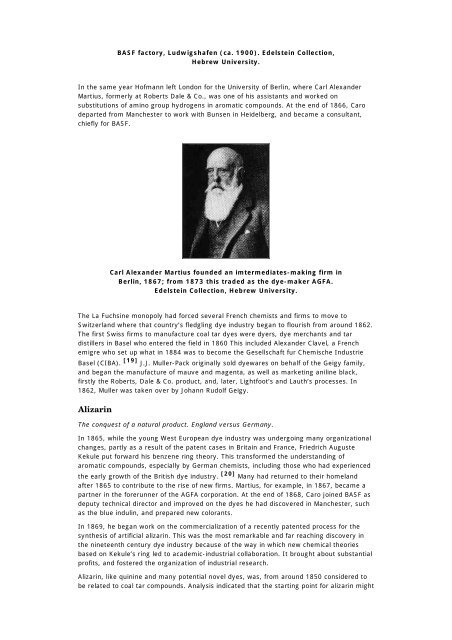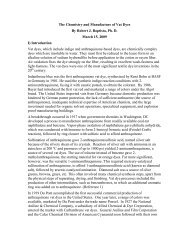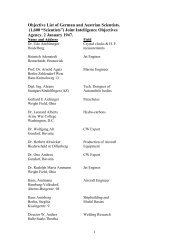International Dyestuff Industry - ColorantsHistory.Org
International Dyestuff Industry - ColorantsHistory.Org
International Dyestuff Industry - ColorantsHistory.Org
Create successful ePaper yourself
Turn your PDF publications into a flip-book with our unique Google optimized e-Paper software.
BASF factory, Ludwigshafen (ca. 1900). Edelstein Collection,<br />
Hebrew University.<br />
In the same year Hofmann left London for the University of Berlin, where Carl Alexander<br />
Martius, formerly at Roberts Dale & Co., was one of his assistants and worked on<br />
substitutions of amino group hydrogens in aromatic compounds. At the end of 1866, Caro<br />
departed from Manchester to work with Bunsen in Heidelberg, and became a consultant,<br />
chiefly for BASF.<br />
Carl Alexander Martius founded an imtermediates-making firm in<br />
Berlin, 1867; from 1873 this traded as the dye-maker AGFA.<br />
Edelstein Collection, Hebrew University.<br />
The La Fuchsine monopoly had forced several French chemists and firms to move to<br />
Switzerland where that country’s fledgling dye industry began to flourish from around 1862.<br />
The first Swiss firms to manufacture coal tar dyes were dyers, dye merchants and tar<br />
distillers in Basel who entered the field in 1860 This included Alexander Clavel, a French<br />
emigre who set up what in 1884 was to become the Gesellschaft fur Chemische Industrie<br />
Basel (CIBA). [19] J.J. Muller-Pack originally sold dyewares on behalf of the Geigy family,<br />
and began the manufacture of mauve and magenta, as well as marketing aniline black,<br />
firstly the Roberts, Dale & Co. product, and, later, Lightfoot’s and Lauth’s processes. In<br />
1862, Muller was taken over by Johann Rudolf Geigy.<br />
Alizarin<br />
The conquest of a natural product. England versus Germany.<br />
In 1865, while the young West European dye industry was undergoing many organizational<br />
changes, partly as a result of the patent cases in Britain and France, Friedrich Auguste<br />
Kekule put forward his benzene ring theory. This transformed the understanding of<br />
aromatic compounds, especially by German chemists, including those who had experienced<br />
the early growth of the British dye industry. [20] Many had returned to their homeland<br />
after 1865 to contribute to the rise of new firms. Martius, for example, in 1867, became a<br />
partner in the forerunner of the AGFA corporation. At the end of 1868, Caro joined BASF as<br />
deputy technical director and improved on the dyes he had discovered in Manchester, such<br />
as the blue indulin, and prepared new colorants.<br />
In 1869, he began work on the commercialization of a recently patented process for the<br />
synthesis of artificial alizarin. This was the most remarkable and far reaching discovery in<br />
the nineteenth century dye industry because of the way in which new chemical theories<br />
based on Kekule’s ring led to academic-industrial collaboration. It brought about substantial<br />
profits, and fostered the organization of industrial research.<br />
Alizarin, like quinine and many potential novel dyes, was, from around 1850 considered to<br />
be related to coal tar compounds. Analysis indicated that the starting point for alizarin might





